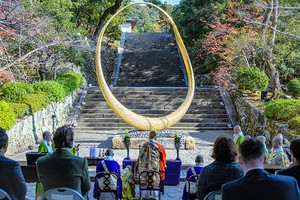THE ASAHI SHIMBUN
March 10, 2024 at 18:55 JST
 Stablemaster Miyagino, left, stands next to Hokuseiho on Feb. 23. (Asahi Shimbun file photo)
Stablemaster Miyagino, left, stands next to Hokuseiho on Feb. 23. (Asahi Shimbun file photo)
The Miyagino stable, formerly managed by retired yokozuna Hakuho, who won the most championships in the history of sumo, may have to close because of a scandal involving repeated acts of violence by his disciple, sources said.
The Isegahama “ichimon” group, to which the Miyagino stable belongs, plans to transfer all its wrestlers to one or more stables within the group, the sources said March 9.
The plan was expected to be presented to the Japan Sumo Association as early as March 10.
If the association approves the proposal, the Miyagino stable will be effectively closed.
One of the proposals being considered would transfer the wrestlers to three stables, Isegahama, Oshima and Asahiyama, the sources said.
Sumo elders of the Isegahama group met in Osaka on March 8 to discuss what to do with the Miyagino stable from April following the scandal, in which Hokuseiho repeatedly assaulted two wrestlers.
The JSA has criticized stablemaster Miyagino, who wrestled as Hakuho and won 45 tournaments before his retirement in 2021, for failing to admonish Hokuseiho and report his behavior to the association.
Those who attended the March 8 meeting agreed that it will be difficult to maintain the stable as it is, the sources said.
Miyagino and Magaki, a sumo elder attached to the Miyagino stable, are expected to be moved to different stables, the sources said.
Hokuseiho, who is 22 and from Mongolia like Hakuho, is no longer part of the sumo world.
An extraordinary JSA board meeting on Feb. 23 decided to demote Miyagino by two notches to the lowest rank of “toshiyori” and cut his pay by 20 percent for three months.
He was also removed from the stable’s management. Tamagaki, a sumo elder attached to the Oshima stable, has temporarily taken over as acting master of the Miyagino stable.
In 2010, the Dewanoumi group took over management of the Kise stable after its stablemaster was found to have given favors to gangsters.
Thirty or so wrestlers of the Kise stable were transferred to the Kitanoumi stable within the same group. The Kise stable was reopened two years later.




















A peek through the music industry’s curtain at the producers who harnessed social media to help their idols go global.
A series based on diplomatic documents declassified by Japan’s Foreign Ministry
Here is a collection of first-hand accounts by “hibakusha” atomic bomb survivors.
Cooking experts, chefs and others involved in the field of food introduce their special recipes intertwined with their paths in life.
A series about Japanese-Americans and their memories of World War II